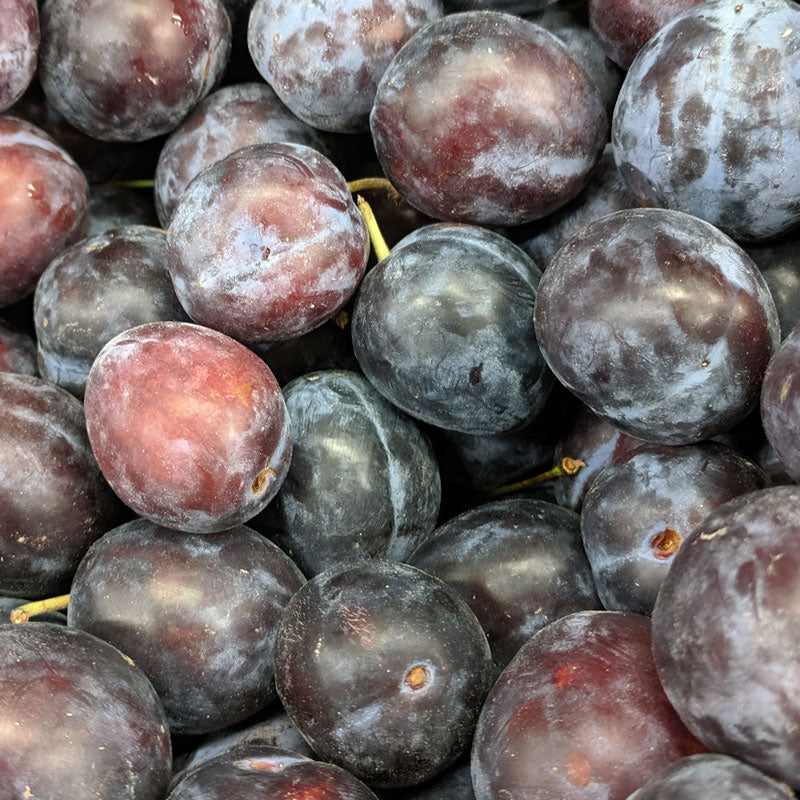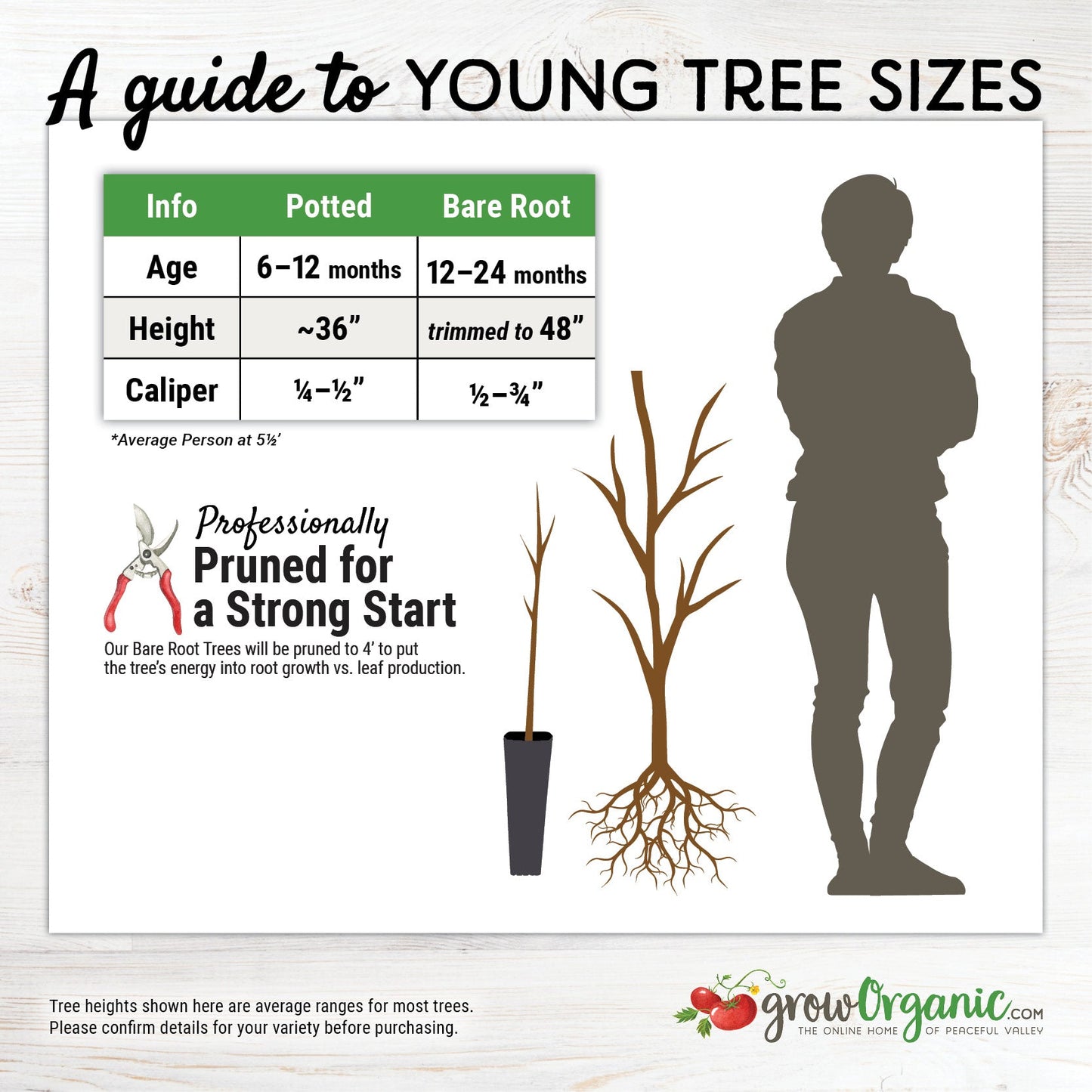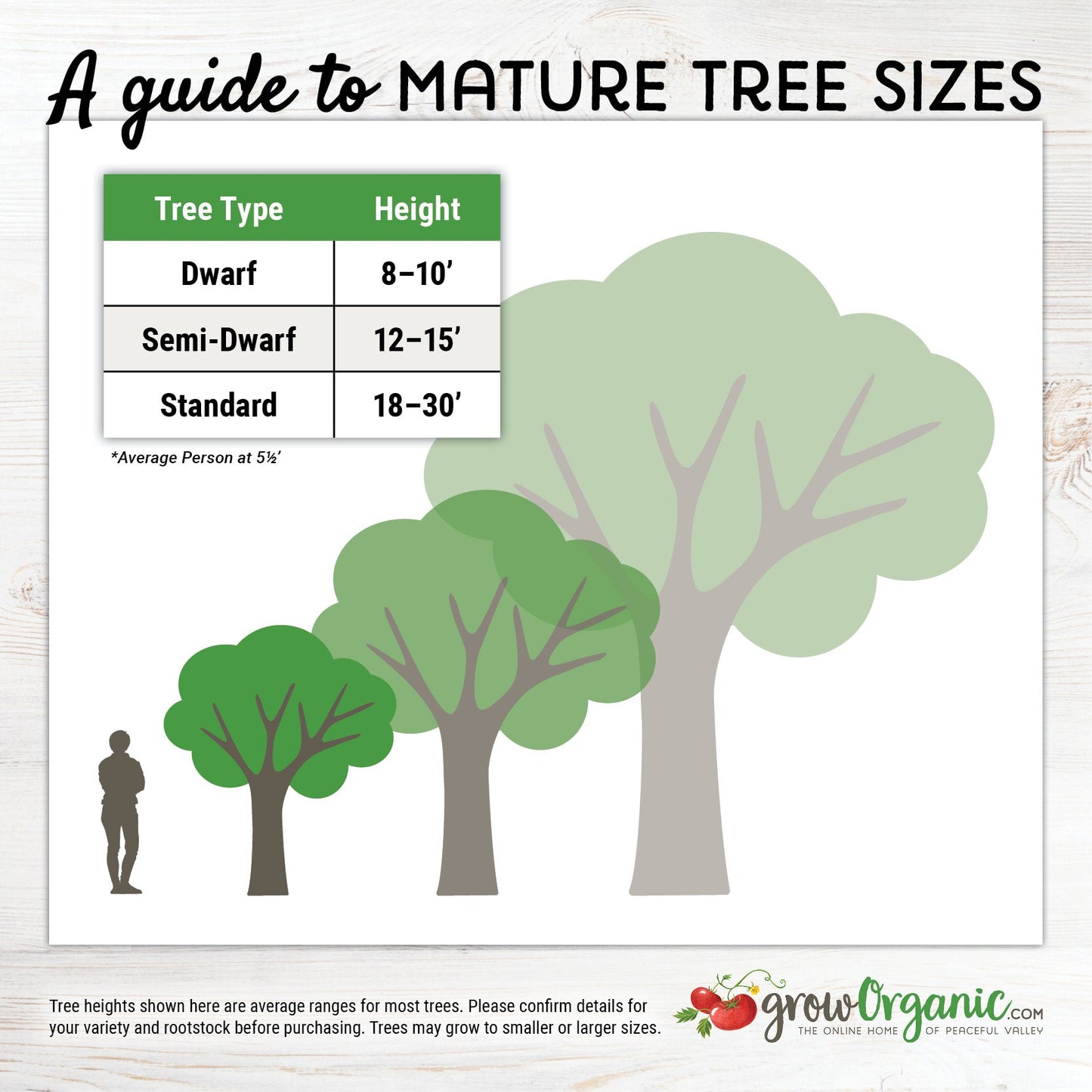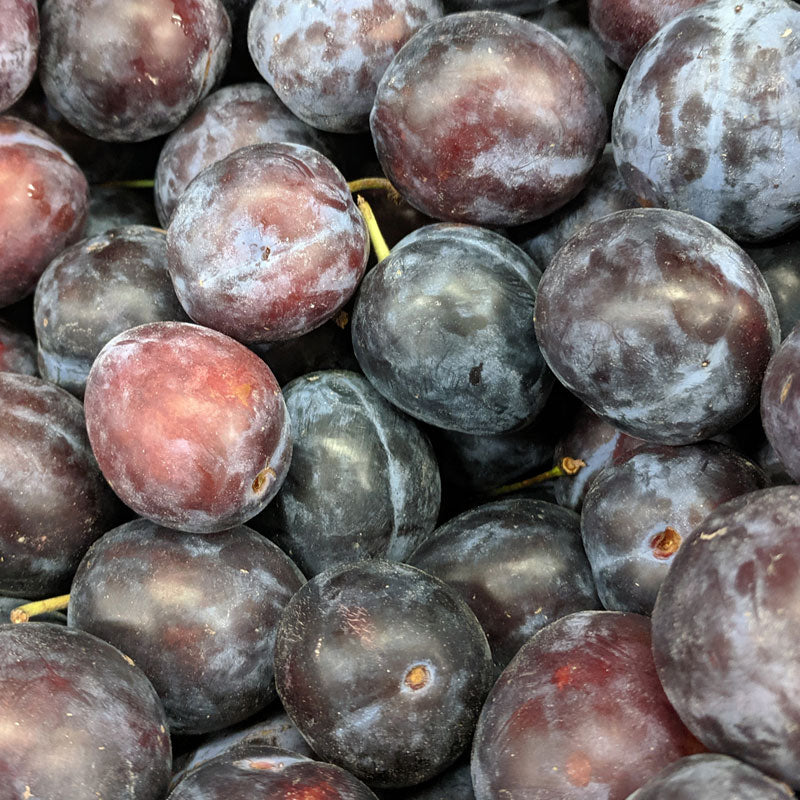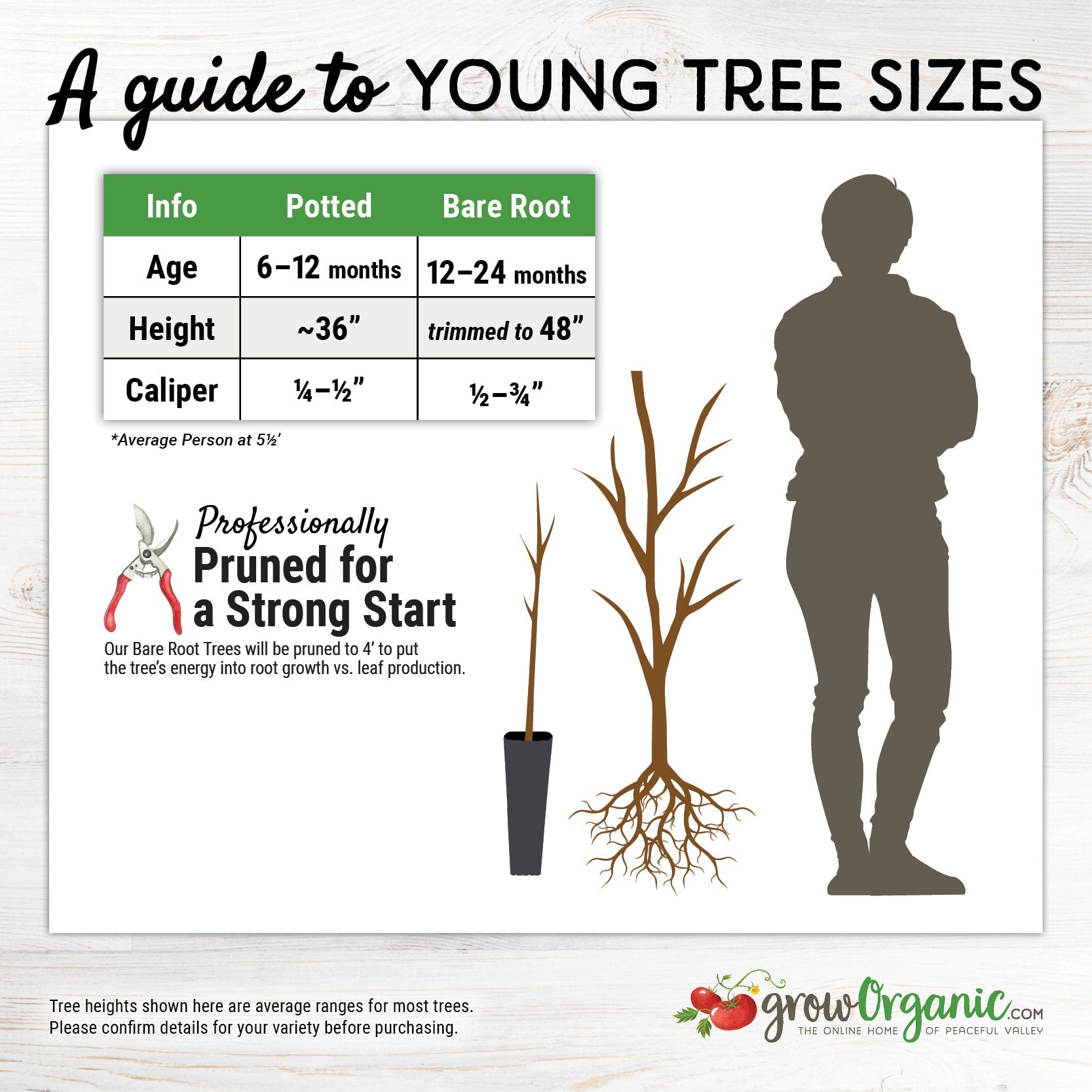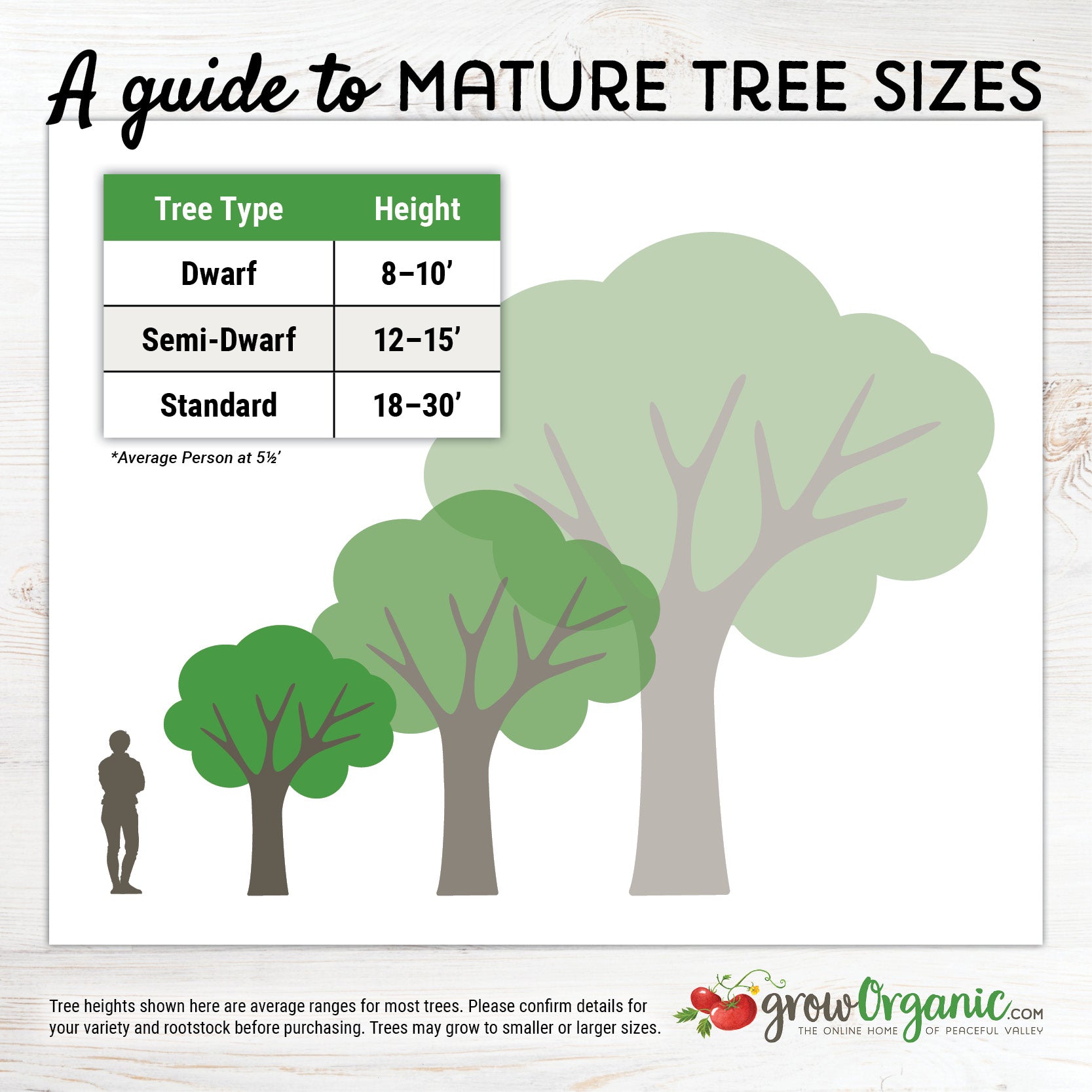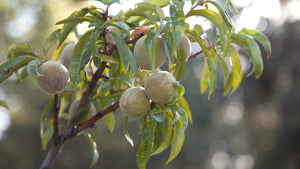Item Number: FT204
Italian Plum Tree
Italian Plum Tree
Hardy and Reliable
Semi-dwarf on Citation rootstock.
- Zones: 5-9
- Chill hours: 300-800
- Harvest: August-September
- Looks: Large, purple-skinned freestone. Greenish yellow flesh that turns red when cooked.
- Personality: Rich flavor, very sweet, use fresh, dried, canned.
- Facts of note: The Italian Plum or prune-plum is thought to have originated in Italy. One of the most popular home garden varieties of European plum, the variety has found more success outside of Italy since its introduction. Concentrated flowery fruit flavor and dense texture making it ideal for fresh eating, drying or dehydrating, or cooked into any of a number of popular culinary dishes. When cooked down the resulting concentrate has a rich jammy consistency. Low in water when cooked down tit has rich sugary fruity flavor. Self fruitful and cold hardy and rich in fiber, Vitamins A, C and K along with antioxidants.
- Pollination: Self-fruitful.
The Italian Plum tree, scientifically known as Prunus domestica, is a delightful addition to any garden or orchard. Known for its sweet and succulent fruits, this semi-dwarf tree is a favorite among fruit enthusiasts and home gardeners.
Characteristics of the Italian Plum Tree
The Italian Plum tree, also referred to as European Plum, stands out with its unique characteristics:
Semi-Dwarf Growth: This particular variety of plum tree is classified as semi-dwarf. It typically reaches a manageable height of 12 to 15 feet when fully mature, making it suitable for smaller gardens or orchards where space is limited.
Fruit Size and Flavor: Italian Plums are renowned for their exquisite flavor. The fruits are small to medium-sized, usually oval or oblong in shape, and have a deep purple or blue skin with a sweet and slightly tart flavor. These plums are perfect for fresh eating, baking, and making jams and preserves.
Blossoms: In the spring, Italian Plum trees produce beautiful white or pale pink blossoms that add a touch of elegance to your garden. These blossoms are not only aesthetically pleasing but also serve as an essential stage in the tree's fruiting process.
Self-Fertile: One of the notable features of Italian Plum trees is that they are self-fertile, meaning they do not require a second plum tree for pollination. However, planting multiple plum trees can increase fruit production.
Cultivation Tips for Italian Plum Trees
Growing and caring for Italian Plum trees can be a rewarding experience. Here are some key cultivation tips to help you successfully nurture this semi-dwarf fruit tree:
Location: Choose a sunny spot in your garden or orchard with well-draining soil for your Italian Plum tree. Adequate sunlight is essential for fruit production and flavor development.
Planting: When planting your Italian Plum tree, dig a hole deep and wide enough to accommodate the root system comfortably. Ensure that the graft union (the swollen area on the lower trunk) is above the soil line.
Pruning: Regular pruning is crucial for maintaining the tree's shape, removing dead or diseased branches, and encouraging optimal fruit production. Prune during the dormant season, typically in late winter or early spring.
Watering: Provide consistent and deep watering during the growing season, especially during dry spells. Deep watering helps establish a robust root system.
Fertilization: Italian Plum trees benefit from balanced fertilizer applications. Use a fertilizer with a balanced N-P-K (nitrogen, phosphorus, and potassium) ratio to promote healthy growth and fruit development.
Rewards of Growing Italian Plum Trees
The Italian Plum tree offers several rewards to the diligent gardener:
Delicious Harvest: The main reward, of course, is the bountiful harvest of sweet and flavorful plums that can be enjoyed fresh, used in various culinary creations, or preserved for later consumption.
Ornamental Value: Beyond its fruits, the Italian Plum tree adds ornamental value to your garden with its attractive spring blossoms and lush foliage.
Low Maintenance: Semi-dwarf trees like the Italian Plum are relatively low maintenance, making them suitable for both novice and experienced gardeners.
Self-Pollinating: The tree's self-fertile nature simplifies the process of growing plums, as you don't need multiple trees for cross-pollination.
The Italian Plum tree, with its semi-dwarf stature, delectable fruits, and ease of cultivation, is an excellent choice for those looking to enhance their garden or orchard. Whether you're an avid fruit enthusiast or simply enjoy the aesthetic appeal of blossoming trees, the Italian Plum tree offers a delightful and rewarding experience for any gardener.
Visit our Fruit Tree Central for a listing of all our fruit tree videos and articles.
Visit Tree Characteristics for a listing of all our fruit & nut tree growing characteristics.


Check Your Zone Compatibility:
Compatible with your zone.
Growing Zone for
,

Our Guarantee To You
Since 1976, we've served our customers at every stage of growing. Please contact us at any time. We are happy to support and assist you.
Description
Description
Semi-dwarf on Citation rootstock.
- Zones: 5-9
- Chill hours: 300-800
- Harvest: August-September
- Looks: Large, purple-skinned freestone. Greenish yellow flesh that turns red when cooked.
- Personality: Rich flavor, very sweet, use fresh, dried, canned.
- Facts of note: The Italian Plum or prune-plum is thought to have originated in Italy. One of the most popular home garden varieties of European plum, the variety has found more success outside of Italy since its introduction. Concentrated flowery fruit flavor and dense texture making it ideal for fresh eating, drying or dehydrating, or cooked into any of a number of popular culinary dishes. When cooked down the resulting concentrate has a rich jammy consistency. Low in water when cooked down tit has rich sugary fruity flavor. Self fruitful and cold hardy and rich in fiber, Vitamins A, C and K along with antioxidants.
- Pollination: Self-fruitful.
The Italian Plum tree, scientifically known as Prunus domestica, is a delightful addition to any garden or orchard. Known for its sweet and succulent fruits, this semi-dwarf tree is a favorite among fruit enthusiasts and home gardeners.
Characteristics of the Italian Plum Tree
The Italian Plum tree, also referred to as European Plum, stands out with its unique characteristics:
Semi-Dwarf Growth: This particular variety of plum tree is classified as semi-dwarf. It typically reaches a manageable height of 12 to 15 feet when fully mature, making it suitable for smaller gardens or orchards where space is limited.
Fruit Size and Flavor: Italian Plums are renowned for their exquisite flavor. The fruits are small to medium-sized, usually oval or oblong in shape, and have a deep purple or blue skin with a sweet and slightly tart flavor. These plums are perfect for fresh eating, baking, and making jams and preserves.
Blossoms: In the spring, Italian Plum trees produce beautiful white or pale pink blossoms that add a touch of elegance to your garden. These blossoms are not only aesthetically pleasing but also serve as an essential stage in the tree's fruiting process.
Self-Fertile: One of the notable features of Italian Plum trees is that they are self-fertile, meaning they do not require a second plum tree for pollination. However, planting multiple plum trees can increase fruit production.
Cultivation Tips for Italian Plum Trees
Growing and caring for Italian Plum trees can be a rewarding experience. Here are some key cultivation tips to help you successfully nurture this semi-dwarf fruit tree:
Location: Choose a sunny spot in your garden or orchard with well-draining soil for your Italian Plum tree. Adequate sunlight is essential for fruit production and flavor development.
Planting: When planting your Italian Plum tree, dig a hole deep and wide enough to accommodate the root system comfortably. Ensure that the graft union (the swollen area on the lower trunk) is above the soil line.
Pruning: Regular pruning is crucial for maintaining the tree's shape, removing dead or diseased branches, and encouraging optimal fruit production. Prune during the dormant season, typically in late winter or early spring.
Watering: Provide consistent and deep watering during the growing season, especially during dry spells. Deep watering helps establish a robust root system.
Fertilization: Italian Plum trees benefit from balanced fertilizer applications. Use a fertilizer with a balanced N-P-K (nitrogen, phosphorus, and potassium) ratio to promote healthy growth and fruit development.
Rewards of Growing Italian Plum Trees
The Italian Plum tree offers several rewards to the diligent gardener:
Delicious Harvest: The main reward, of course, is the bountiful harvest of sweet and flavorful plums that can be enjoyed fresh, used in various culinary creations, or preserved for later consumption.
Ornamental Value: Beyond its fruits, the Italian Plum tree adds ornamental value to your garden with its attractive spring blossoms and lush foliage.
Low Maintenance: Semi-dwarf trees like the Italian Plum are relatively low maintenance, making them suitable for both novice and experienced gardeners.
Self-Pollinating: The tree's self-fertile nature simplifies the process of growing plums, as you don't need multiple trees for cross-pollination.
The Italian Plum tree, with its semi-dwarf stature, delectable fruits, and ease of cultivation, is an excellent choice for those looking to enhance their garden or orchard. Whether you're an avid fruit enthusiast or simply enjoy the aesthetic appeal of blossoming trees, the Italian Plum tree offers a delightful and rewarding experience for any gardener.
Visit our Fruit Tree Central for a listing of all our fruit tree videos and articles.
Visit Tree Characteristics for a listing of all our fruit & nut tree growing characteristics.
About Plums: Plums are not generally self-pollinated and can be tricky to grow in areas with late frosts but are superb for fresh eating. They are the favored fresh eating varieties in the United states being larger, firmer fleshed, and rounder than European plums. Japanese plum trees have rougher bark, more persistent spurs, and more numerous flowers than European plums. They are also more precocious, disease resistant, and vigorous than European plums. Japanese plum flavor ranges from sweet to tart. Browse all our plum trees for sale.
Please Note: Although most of our bare-root trees arrive to our warehouse in mid-December, there are a few varieties that will not arrive until mid-January. If you order any of those varieties along with varieties that arrive in mid-December, your order will be delayed for shipment until mid-January. If you'd like us to split your shipments, please contact us at (888) 784-1722 or orderdesk@groworganic.com. Additional shipping charges will apply.
Shipping Information
Shipping Information
Cannot ship to the following states: HI, AK, PR, GU, VI
Cannot ship via USPS.
Cannot ship via SmartPost.
Shipping Weight: 5.0 lb
Dimensions: 55.5"L x 7.3"W x 2.75"H
Features
Features
- Self-fruitful
- Suited to Cold Climates
Characteristics
Characteristics
Planting & Care
Planting & Care
Useful Information
Useful Information
Guarantee
Guarantee
Limited Dormant Tree & Plant Guarantee
* Claim deadline is June 15th
We guarantee that your dormant tree or plant will arrive in good, viable condition. If your tree arrives in substandard condition, notify us within 3 days of delivery. Please email pictures of the box, inside packaging, the tree and its roots to helpdesk@groworganic.com. We will investigate your claim and process a request to exchange or refund the damaged product.
If your dormant tree or plant has not grown new leaves by June 15th, you may be eligible for our Limited Dormant Tree & Plant Guarantee. This guarantee provides for a store credit for the purchase price of the tree, excluding shipping. Please see the Instructions below.
Important Dates:
- April 1st Dormant trees/plants must be planted in the ground
- May 15th Perform scratch test, if no new leaves have grown
- June 15th Deadline to apply for a dormant tree/plant credit
All required documentation must be received by June 15th for your claim to be considered. Claims or documentation received after June 15th will be denied, without exception. Instructions listed below
Terms and Conditions
We cannot guarantee that your tree or plant will remain alive and healthy after it is received, or bear fruit as there are too many variables in your environment that are beyond our control (i.e. soil preparation, weed and pest control, proper irrigation, chill hours, compatible hardiness for your growing zone, proper choice of pollinator, extreme weather, rodent damage, disease, etc.).
We cannot guarantee that we will be able to provide a replacement tree/plant of the same species either that same growing season or in future years. Customers are responsible for all shipping fees associated with replacement trees and plants.
If we determine that the tree you purchased directly from us is not viable, we will issue you a store credit (not a refund) for the purchase price of the affected dormant tree or plant. Shipping is not included in the dormant tree/plant guarantee. Store credits can be used to purchase any product we sell and are valid for use only until July 1st of the following year.
Historically, 98% of our dormant trees and plants grow and thrive when they have been cared for and planted using our growing guides. Dormant trees and plants must be planted in the ground by April 1st in order to be eligible for credit. If the ground in your area is still frozen solid, you may temporarily plant your tree or plant in a pot.
Potted, non-dormant trees or plants are excluded from this guarantee as they are not dormant at the time of shipment. Evergreen trees such as citrus, avocado and olive trees are not available for credit under the Dormant Tree and Plant Guarantee.
Instructions
We guarantee that your dormant fruit tree or plant will leaf out, if you care for it according to our growing guides. In the unlikely event that your dormant tree or plant does not have leaves by May 15th, follow these simple steps to apply for a store credit:
Before you call or email, please perform a “scratch test” to determine if the tree or plant is still alive. This video shows how to check for live tissue under the bark. Scratch tests need to be done a few inches above and below the graft.
Green Cambium Layer / Living Trees
If the cambium layer under the bark is green, give your tree a little more time. It is still alive, but hasn’t come out of dormancy yet. Check to make sure that it is getting the right amount of deep root water, enough sunlight and that the weather is warm enough for that type of tree/plant to come out of dormancy. Every tree has its own personality and will come out of dormancy at different times. Be sure to submit the required documentation listed below by June 15th, if it doesn’t grow leaves.
Brown Cambium Layer / Dead Trees
If the scratch test shows a brown cambium layer or if your dormant tree/plant doesn’t have leaves by June 1st, please email us at helpdesk@groworganic.com. All required documentation listed below must be received by June 15th for your claim to be considered. To be considered for the guarantee claim, all required documentation must be received by June 15th. Incomplete submissions will be denied.
Required Documentation
- Order number
- Name of dormant tree/plant and the quantity affected
- Photos of each tree or plant showing:
- The roots (tree or plant must be pulled out of the ground)
- The scratch test areas
- The entire tree/plant
We reserve the right to not issue credit for items that have already been replaced. We also reserve the right to require photographic evidence that the tree/plant was not killed by root rot, rodent or mechanical damage.
Share
